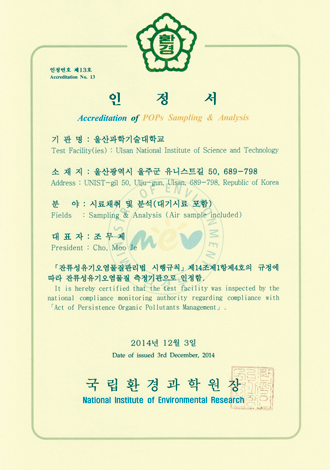-

Welcome to your visit to the UEAC (UNIST Environmental Analysis Center) website.
UEAC was established to make UNIST the best educational and research institute in the field of environmental analysis in a short period of time.
We provide analytical services of persistent organic pollutants (POPs), endocrine disrupting chemicals (EDCs), and heavy metals using various instruments, such as a high resolution mass spectrometer.
We expect your continuous interest in research activities of UEAC, and please do not hesitate to contact us when you need scientific consultations on ultra-trace level analysis of environmental pollutants.
-
The top-level of environmental analysis agency
- Act of the Persistence Organic Pollutants Management < Accreditation No. 13 >
The objectives of UEAC are as follows
- To be a top-level environmental analysis center
- To train graduate students to be experts in the field of environmental analysis
- To get various research projects with domestic and international certifications
- To enhance professors’ research capability through analytical service of POPs and heavy metals.
-
012009 – 2010 1st Step
- Center for PCBs
(Ministry of Environment)
- Center for PCBs
-
022010 – 2015 2nd Step
- Center for PCDD/Fs
(Ministry of Environment)
- Center for PCDD/Fs
-
032015 -2020 3rd Step
- Total solutions for Environmental Analysis
- Research & Business model at UNIST
 Accreditation of POPs Sampling & Analysis
Accreditation of POPs Sampling & Analysis
-
Persistent organic pollutants (POPs)
Persistent organic pollutants (POPs) are organic chemicals that are persistent in the environment, bioaccumulative through food chains, and endocrine disrupting or carcinogenic. They also undergo long-range atmospheric transport (LRAT) and even reach to polar regions. In 2001, the United Nations Environment Program (UNEP) adopted the Stockholm convention for the global regulation of POPs, which went into effect from 2004. The list of POPs under the Stockholm convention contains 12 kinds of chemicals including polychlorinated dibenzo-p-dioxin/furans (PCDD/Fs), polychlorinated biphenyls (PCBs), hexachlorobenzene (HCB), and organochlorine pesticides (OCPs).
POPs (in 1995),New POPs (in 2001) POPs (in 1995) New POPs (in 2001) - Polychlorinated biphenyls (PCBs)
- Dioxins
- Furans
- Adrin
- Dieldrin
- DDT
- Chlordane
- Hexachlorobenzene
- Mirex
- Toxaphene
- Heptachlor
- a,b-hexachlorocyclohexane
- Chlorodecone
- HBCDs
: Hexabromocyclododecanes - PBBs
Hexabromobiphenyls - PBDEs
: Hexabromodiphenyl ether
: Hexabromodiphenyl ether ether
: Tetrabromodiphenyl ether
: Pentabromodiphenyl ehter - Lindane
- Pentachlorobenzene
- Perfluorooctane sullfronic acid
- Endosulfans
잔류성 유기오염물질 Category Stbustance Organochlorine pesticide Aldrin, Chlordane, DDT, Dieldrin, Endrin, Heptachlor, Mirex,
Toxaphene, HCB (hexachlorobenzene)Industrial chemical PCBs (polychlorinated biphenyls) Byproduct Dioxins, Furans, PCBs, HCB (hexachlorobenzene) Experimental procedures for POPs
There are three steps for the analysis of POPs: (1) Sample collection, (2) Pre-treatment process (extraction, cleanup, and evaporation), (3)Instrumental analysis. These experimental procedures and the use of mass spectrometers have been well defined. In general, Soxhlet apparatus or accelerated solvent extractor (ASE) is used for the solvent extraction of organic compounds from solid samples. Extracts are evaporated by a rotary evaporator and cleaned up on silica and alumina columns. The extracts are again evaporated by a nitrogen evaporator. Finally, quantitative and qualitative analysis are done by the use of a mass spectrometer or other proper instruments.
-
Extraction
 ASE/Soxhlet
ASE/Soxhlet -
Cleanup
 Sliica/Alumina column
Sliica/Alumina column -
Concentration
 Turvo Vap/Rotary Evaporator
Turvo Vap/Rotary Evaporator -
Instrumental analysis
 HRGC/HRMS
HRGC/HRMS